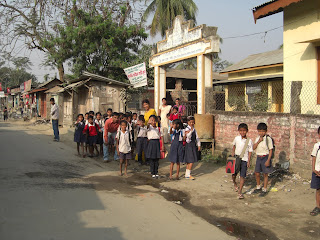We flew from Communist Kolkata (where the jute workers, encouraged by the CPM government, have been on indefinite strike since the 14th December) to ultra modern Bangalore, the pinnacle of India’s booming IT industry.
 The silicon-coated heart of India was immediately evident from the shuttle-bus airport transfer. Here, Infosys, the Indian IT giant, has its HQ. Established less than 20 years ago, today the company has over 100,000 employees and revenues of US$4bn. Its clients currently include nearly 100 Fortune 500 companies. Its 32-hectare campus (which we passed but unfortunately failed the stringent security checks to have a snoop around!) comprises shiny glass and steel structures sprouting from perfectly manicured lawns.
The silicon-coated heart of India was immediately evident from the shuttle-bus airport transfer. Here, Infosys, the Indian IT giant, has its HQ. Established less than 20 years ago, today the company has over 100,000 employees and revenues of US$4bn. Its clients currently include nearly 100 Fortune 500 companies. Its 32-hectare campus (which we passed but unfortunately failed the stringent security checks to have a snoop around!) comprises shiny glass and steel structures sprouting from perfectly manicured lawns.Despite this glimpse of an alternative India, the wealth has not spread throughout Bangalore, or indeed, Karnataka, the state in which it lies. 62% of Bangalore’s population are ‘Indo-nationals’, meaning they originate from other Indian states as far as Punjab, Rajasthan and Assam. The majority of them who fill the vacancies at Tata Consultancy, Goldman Sachs, Intel and the like are India’s privileged few who have been to private schools and one of India’s up-and-coming universities (at a fee). From the young professionals we spoke to, it appears only a limited list of science-based degrees, such as Engineering and Computer Science, hold any value in India. A reflection of this system is portrayed eloquently in the recent hit Bollywood movie, ‘The 3 Idiots’. As Arindam Chaudhuri, editor in chief of Planman Media comments, “the film has a strong message to the many idiots running the education system of this country and to the millions of idiots who accept this system without questioning.” The fact is that many able arts candidates are understandably put off by the lack of job prospects open to them when they graduate and are instead forced to study engineering or computer science. The drop-out rate is not high, but the student suicide rate is.
In Bangalore, Pratham has been working in collaboration with the Akshara Foundation (http://www.aksharafoundation.org/) since 2000. In the Pratham office in the Bangalore suburbs, Ashok, the well-spoken Chair person showed us the impressive database (http://www.klp.org.in/) by which they track 725,000 children across Karnataka.
 The aim is to quadruple that number by the end of this year and to reach 13 million in 3 years time. The Pratham-Akshara interventions are 60 sessions long in, for example, Kanada (the state’s first language), Urdu, Maths and English, over 3 to 5 months. Each child is tested at the beginning and end of the programme to monitor their progress. Pratham-Akshara don’t just work in Bangalore but across Karnataka and particularly in the North, in areas like Bidar and Gulbarga which have much lower HDI ratings and are mainly dependent on agriculture.
The aim is to quadruple that number by the end of this year and to reach 13 million in 3 years time. The Pratham-Akshara interventions are 60 sessions long in, for example, Kanada (the state’s first language), Urdu, Maths and English, over 3 to 5 months. Each child is tested at the beginning and end of the programme to monitor their progress. Pratham-Akshara don’t just work in Bangalore but across Karnataka and particularly in the North, in areas like Bidar and Gulbarga which have much lower HDI ratings and are mainly dependent on agriculture.In the afternoon Tasmiya, who is in charge of Shivnagar district, took us to visit a government Urdu higher primary school in Frager town. On the bumpy rickshaw ride through Bangalore, she told us how over the last 10 years she’s seen the Pratham-Akshara collaboration grow from serving just 20 school drop-outs between 7-14 years old to over 350,000 children in Bangalore today. At the Muslim school we met the librarians who showed us the impressive collection of Urdu (the first language in Muslim families), Kanada (the first language in Karnataka), Hindi (supposedly the national language, though this is contested down south), Tamil (spoken to the East in Tamil Nadu), Telugu (to the North in Andhra Pradesh) and English. The boys in the class were extremely enthusiastic to read us English stories, particularly one eager boy named Asif. His Father was a rickshaw driver although he had aspirations to study Engineering and work for one of the proliferation of high-tech companies, like Infosys. Ten years ago, this dream would have been just that. Today, with Pratham’s extra tuition and English language materials, the son of a rickshaw driver, like many of his classmates, can indeed make his dream a reality.
From here Jen and I are making our way to Gokarna to spend a few days at the coast before returning to hectic London. It’s been an absolutely thrilling journey, travelling around India with Pratham and experiencing a diverse and genuine flavour of India. We’d like to thank everyone whos made it possible for us to have this incredible experience – all of the Pratham coordinators and the team back in Mumbai, especially Anamara. Thank you and Namaste!
______________________________________________________
www.pratham.org
www.pratham.org.uk
www.prathamusa.org
woke up


















